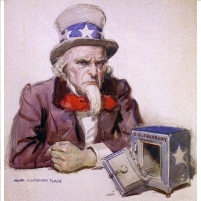Government Debt, at All Levels, Reaches Post-World War II Levels
Friday, February 25, 2011

The United States has reached a level of combined government indebtedness not seen since the end of World War II, when the federal government borrowed heavily to fight a two-front war in Europe and the Pacific. Nowadays, the U.S. debt is serious at all levels, from Washington to state capitols to local governments.
The post-WWII federal debt was nearly 108% of the gross domestic product (GDP), meaning it was larger than the entire U.S. economy. State and local governments hardly had any debt then, but now they have helped push the total U.S. debt (feds included) to 85% of GDP...not counting the money the federal government owes to the Social Security Trust Fund.
While there might be some solace in knowing the percentage is smaller than it was in 1946, the prospects for lowering the debt are weak.
The U.S. was able to pay off a sizeable chunk of the post-war national debt by the early 1950s because it had a young, hungry labor force, growing manufacturing operations, high personal savings and a pent-up demand for consumer goods
“But today the U.S. economy is in a polar opposite condition,” writes Steven Mufson in The Washington Post. “The labor force is aging, U.S. manufacturing often lags behind Asian and European rivals, households are in hock up to their eyeballs, and consumer appetite for goods is tepid.”
The federal debt (not including what was owed to the Social Security fund) fell to 24% of the GDP in 1974, but rose to 49% in 1993 due to the combination of tax cuts and increased spending set in motion by President Ronald Reagan. President Bill Clinton’s policies caused the rate to drop back to 32.5% in 2000, but since then the rate has skyrocketed.
-Noel Brinkerhoff, David Wallechinsky
Federal, State and Local Debt Hits Post-WWII Levels (by Steven Mufson, Washington Post)
Huge Leap in Debt Dumped on Taxpayers…Before Obama (by Noel Brinkerhoff, AllGov)
- Top Stories
- Unusual News
- Where is the Money Going?
- Controversies
- U.S. and the World
- Appointments and Resignations
- Latest News
- Trump Goes on Renaming Frenzy
- Trump Deports JD Vance and His Wife
- Trump Offers to Return Alaska to Russia
- Musk and Trump Fire Members of Congress
- Trump Calls for Violent Street Demonstrations Against Himself






Comments